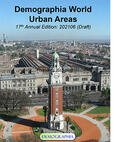The Census Bureau recently released data on domestic migration that took place during the COVID-19 pandemic, and their findings were heavily covered in the press with headlines such as “Cities Lost Population in 2021” and “The pandemic city exodus revealed: New York, Los Angeles, San Francisco and Chicago lost the most residents.” read more »
New York
Americans Do Not Want to Return to Urban Living
- Login to post comments
The Last Utopia: The 15-Minute City
Mayors and urban planners have crucial roles in the management of cities. They must help cities adapt rapidly when confronted with external shocks—the pandemic is only the latest one of these. To be a prudent and efficient janitor is the main task of mayors. read more »
- Login to post comments
New Rankings Disrespect Management of Companies in Flyover Country
It’s no surprise that the latest “authoritative” ranking of management acumen at U.S. companies relegates those headquartered in Flyover Country mostly to the bottom of the list. But this list sure is frustrating – and wrong-headed. And its bias matters. read more »
- Login to post comments
Exposure Density, Overcrowding and COVID Death Rates: Update
In their new book, Harvard economists Edward Glaeser and David Cutler characterize COVID and related issues as an “existential threat to the urban world, because the human proximity that enables contagion is the defining characteristic of the city” (see our review, Survival of the City: The Need to Reopen the Metropolitan Frontier (Review). read more »
- Login to post comments
The Battle for Cities
America’s cities face an existential crisis that threatens their future status as centers of culture, politics, and the economy. Many urban advocates continue to delude themselves that U.S. cities are about to experience a massive post-pandemic return to “normal.” But the disruptive technological, demographic, and social changes of recent times are more likely to upend the old geographic hierarchy than to revive it. read more »
- Login to post comments
Focusing on World Megacities: Demographia World Urban Areas, 2021
The 2021 edition of Demographia World Urban Areas includes current population estimates for the 985 identified built-up urban areas (Note 1 describes the background and methodology) with at least 500,000 population.This is a smaller number than last year, due to a methodology that rendered somewhat lower populations for some urban areas. read more »
- Login to post comments
The Next Entrepreneurial Revolution
The coronavirus pandemic has altered the future of American business. The virus-driven disruption has proved more profound than anything imagined by Silicon Valley, costing more jobs than in any year since the Great Depression. read more »
Census Bureau Releases 2020 City Population Estimates
The US Census Bureau has just released its July 1, 2020 population estimates for the approximately 19,500 incorporated municipalities (principally called cities, towns, villages). This article provides information on the 50 largest municipalities in the nation (Table below). read more »
Combined Statistical Areas Lead Continuing Dispersion: 2010-2020
A commenter asked about population trends in combined statistical areas (CSA) in response to my article “Demographic Implosion in the San Francisco Bay Area?, posted on May 18. This article deals with CSA population trends in the 88 CSAs with more than 500,000 population. read more »
- Login to post comments
Even the Manhattan Institute Says Curb Your Car
If an early April panel discussion (virtual) of the Manhattan Institute on “Planning the Post-Covid City” was surprisingly progressive, maybe it was because this talk of revolution in the streets was about reallocating little more than parking spaces. Yet that much upheaval is basic, these panelists agreed, to renewal of New York’s pre-pandemic glory. read more »






















